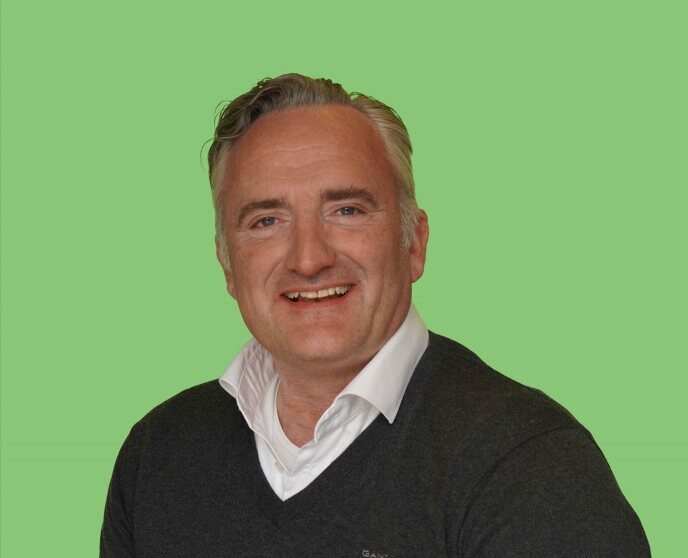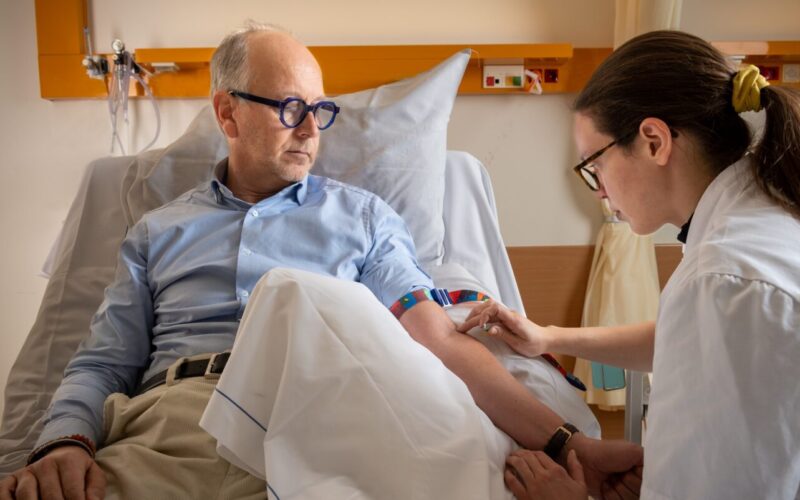“We’re not there yet, but we’re getting closer and closer.” People with ALS are receiving more and more personalized care, and the first treatments are on the horizon. The ALS Center at UMC Utrecht is a hotbed of innovation. Here, four leading researchers bring together genetic research, clinical studies, laboratory models and care research in the fight against this deadly muscle disease. In this four-part series, read how they aim to make ALS a treatable condition, with the best care for all patients.
“We now know that ALS arises from abnormalities in one or more genes,” says Jan Veldink. He is a professor of neurogenetics at the ALS Center and does a lot of research on the genetic cause of ALS. “We also realize that we don’t know all the gene defects yet. The deeper we dive into genetic research, the more genes turn out to be involved in the development of ALS.”

Prof. Jan Veldink is professor of Neurogenetics at the UMC Utrecht. His research focuses mainly on finding genes that underlie ALS.
Together with colleagues around the world, Jan started a large-scale study called Project MinE in 2013 to identify all these different genetic abnormalities. Jan is the leading force behind this project. “So far we have discovered at least 5 abnormalities in the DNA that can cause ALS. This may seem few after 10 years of research. But since there are many different gene defects involved, ALS is a rare disease, and we have to examine the entire DNA to discover new abnormalities, this is still a significant achievement. Especially when you consider that this is a very expensive type of research and we are also collaborating internationally due to the rarity.”
Genetic research and medicine for ALS
Research into the genetic abnormalities that cause ALS is also key to drug development. Jan explains: “For the genetic defects we identify, we can develop gene therapy. In gene therapy, a patient is given, as it were, healthy pieces of DNA without the defects. These healthy pieces correct the errors in the gene defects.”
Jan continues: “We already know from other muscle diseases such as Spinal Muscular Atrophy (SMA) that gene therapy can work very well. Now we are going to apply this to ALS as well. Last summer, we achieved the first success with this: in a clinical study, ALS patients responded for the first time to treatment with gene therapy. An amazing result! This shows that we can indeed treat ALS. However, due to the variety of gene defects, we do have a long way to go.”
A first step in the treatment of ALS
There is good news in ALS research! Scientists have discovered a medicine that may help some patients, namely those with an abnormality in the SOD1 gene. The drug is called Tofersen.
How does Tofersen work?
Tofersen works like this: the drug targets an error in the DNA of the SOD1 gene. This gene defect causes a harmful protein to be produced. As a result, the nerve cells that control the muscles die. As a result, the muscles can no longer work properly.
Tofersen prevents the production of this harmful protein. As a result, it can slow the decline of muscle function. Some patients even experience an increase in muscle strength as a result of the treatment. This is very encouraging. It shows that ALS is basically a treatable disease.
Who can receive treatment?
Currently, a few Dutch ALS patients are receiving the drug, according to a compassionate use program. This program ensures that they can use Tofersen while we wait for official approval.
Where do we go from here?
Although the gene defect in SOD1 is very rare, this is a very important step forward. Tofersen is a form of gene therapy. We know that gene defects cause both hereditary and sporadic ALS.
These initial results show that gene research is a good course to make ALS a treatable disease. There are now many clinical trials underway into gene therapies for the various gene defects in ALS. You can read more about that later in this story. And here you can read more about the drug Tofersen.
New approach in genetic research: looking at larger links
To identify even more gene defects that cause ALS, Jan has taken a new direction. He explains: “In the hereditary variant of ALS, we look at immediate family members of a patient, such as parents, brothers, sisters and children. Or a generation further, to grandparents, uncles, aunts, cousins. With this approach, we have already been able to detect a number of gene defects.”
If a patient has a rare gene defect that immediate family members do not have, it is sporadic ALS. Recently, Jan has taken a different view of this. “We suspect that these sporadic ALS patients are actually members of larger families, without knowing it from each other,” Jan explains. “This may even be true of third-, fourth-, or even fifth-degree relatives who don’t know each other.”
Recent scientific research has shown that those rarer gene defects are likely the key to understanding ALS. Therefore, the goal of this research is to look beyond individual families and look for larger connections in the genetic material of ALS patients.
“We have found that ALS can have many different genetic causes, even within the same family,” notes Jan. “This makes the situation complex, but it also means that we have to keep looking for new genetic patterns to get a better understanding of the disease. This is also how we can eventually develop treatments for all people with ALS.”
Jan acknowledges this new approach may raise ethical questions, including among patients themselves. “Imagine that as a sporadic ALS patient you think you’re the only one in the family, and then we tell you that there may be family connections after all that you don’t know about. I can imagine that can frighten you. But in sporadic ALS, your brothers, sisters and children do not have an increased risk of the disease. In this research, we are studying genetic patterns at a different level.”
The influence of environmental factors on ALS
Project MinE is not only about discovering genetic abnormalities, but also about understanding how the environment can affect our DNA. Smoking, drinking alcohol, and exposure to certain harmful substances can affect our DNA. They do this by attaching small particles to DNA at specific sites. Those particles are called methyl groups.
Jan explains it as follows: “We know that smoking is a risk factor for ALS. By examining these methyl groups, we can understand exactly what the specific effect of smoking is on the development of the disease. The same goes for alcohol consumption. Now we also want to understand how other environmental factors, such as exposure to harmful substances, may affect ALS.”
Artificial intelligence helps unravel genetic cause of ALS
“In order to treat all ALS patients at the earliest possible stage with gene therapy in the future, we need a complete picture of the genetic basis of the disease,” adds Jan. “It would be great if in a few years we can put this genetic puzzle together for all patients.”
In his research, Jan uses artificial intelligence (AI) to solve this complex puzzle. “We are deploying AI to understand the effects of gene defects on nerve cells,” Jan explains. “After all, this is quite a complicated process, with numerous factors at play. AI helps us recognize those patterns. We have also developed a self-learning algorithm that can predict what will go wrong in a nerve cell when a new genetic abnormality occurs.”
But that’s not the only way AI plays a role in this research. Jan continues, “People with sporadic ALS have a combination of genetic defects. Those gene defects often work together to trigger the disease. Finding those combinations is quite a challenge. Here, too, AI serves us. It analyzes combinations of gene defects and how they work together. The algorithm can also predict how new defects would function. This allows us to understand how the biology in a nerve cell changes, how all the protein and molecules are related to the genetic abnormalities, and much more.”
